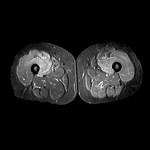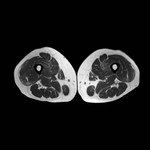Purpose
Late Gadolinium Enhacement (LGE) is commonly used as Magnetic Resonance Imaging marker of myocardial damage in inflammatory cardiomyopathies,
like myocarditis and systemic autoimmune diseases. When associated with T2-STIR,
LGE allows to distinguish acute from chronic myocardial damage.
Our aim was to verify whether LGE might be as informative in the study of skeletal muscle injury,
specifically in inflammatory myopaties,
like polymyosistis (PM) and dermatomyositis (DM).
Only preclinical study on murine modelshave been performed until now [Ref.1].
Methods and Materials
Patients affected by PM and DM underwent upper-legs MRI,
with a1.5T magnet protocol,
including T1 sequences to evaluate fibro-fatty infiltration,
T2-STIR sequences to evaluate edema andLGE sequences for muscle viability.
LGE were ECG-gated fat-suppressed axial IR.
Muscles were divided into 4 anatomical compartments: quadriceps,
adductors,
posterior compartement,
gluteus.
LGEpresence and distribution were visually assessed.
Results
Tenpts were enrolled: 6 DM,
4 PM (8 females,
2 males,
mean age 42,20 ±10,19yrs).
Good quality LGE sequences were obtained.
6pts had positive LGE findings (60%),
showing areas of hyperintense signal: mainly quadriceps and adductors were involved [Fig.
3; Fig.
6].
All pts with LGEhad mildfatty infiltration at T1 [Fig.2; Fig.
5].
STIR was positive in 5 out of 6 pts with late enhancement,
with a similar distribution [Fig.1; Fig.
4].
The 5 pts with LGE and STIR were all symptomatic.
The patient with...
Conclusion
LGE allowed muscle characterization and the mismatch between edema and myocytolitic damage depicted various disease stages,
that still need to be fully understood.
The clinical use of LGE for myocytolitic damage characterization in skeletal muscle,
which has not been previously explored,
appears promising.
References
Ref.
1 : Sciorati C.
et al.
“7-Tesla Magnetic Resonance Imaging Precisely and Noninvasively Reflects Inflammation and Remodeling of the Skeletal Muscle in a Mouse Model of Antisynthetase Syndrome” Hindawi Publishing Corporation BioMed Research International Volume 2014,
Article ID 879703.ue 3,
e59308



